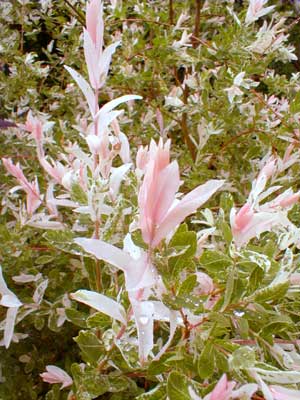 Nishiki Willow's
Nishiki Willow's
Red Twigs in Winter,
Catkins of Spring,
& Pink Leaves of Summer
"In a branch of willow hid
Sings the evening Caty-did."
-Philip Freneau
(1752-1832)
(1752-1832)
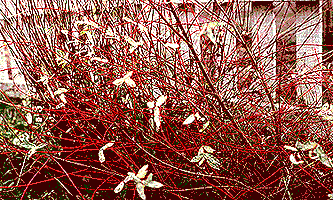 The second photo (here at the right), taken in early December 2001 (over a year after it was planted), is a willow shrub with nearly all the leaves gone, showing the startling limb-color it develops this time of year.
The second photo (here at the right), taken in early December 2001 (over a year after it was planted), is a willow shrub with nearly all the leaves gone, showing the startling limb-color it develops this time of year.There's a larger portrait from winter 2003 can be seen on the Nishiki Willow Page along the Winter Bark Garden Walk. The bark is not red in other seasons. A good plant choice for creating gardens that retain interest even when leaves have fallen.
This cold-hardy cultivar is Salix integra 'Hakuro Nishiki.' It is also sold 'Fuiji Koriangi,' 'Fuiji Nishiki' or 'Albomarginata,' & occasionally with the name 'Hakuro Hishiki' which appears to be a common mispelling as on the commercially printed label on the specimen we obtained so many years ago.
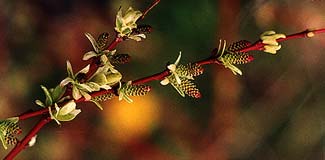 It is also variously sold with such common names as Dappled Japanese Willow, Variegated Willow, & by other names. I once saw it offered as "Red Twig Willow" but since the limbs are only red in winter most nurseries don't try to draw attention to this feature which won't be evident when they're selling them.
It is also variously sold with such common names as Dappled Japanese Willow, Variegated Willow, & by other names. I once saw it offered as "Red Twig Willow" but since the limbs are only red in winter most nurseries don't try to draw attention to this feature which won't be evident when they're selling them. Nishiki Willow has over time come to be preferred. This Japanese name alludes to a brocade design evoked by the leaves & frequently used in obi or kimono-girdle cloth.
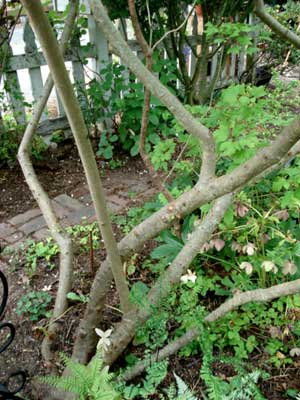 We'd long permitted ours to go twiggy & wild as we don't prefer shrubs that look in any way poodled, but it is quite amenable to pruning, & regular pruning can even be recommended to increase the coloration of the winter limbs, since newer growth will be the reddest.
We'd long permitted ours to go twiggy & wild as we don't prefer shrubs that look in any way poodled, but it is quite amenable to pruning, & regular pruning can even be recommended to increase the coloration of the winter limbs, since newer growth will be the reddest.As the shrub ages, the oldest central branching trunks become substantial as for small trees, & no longer change color in winter, though it will always produce new twigs so will always have colorful winter bark. By 2008 our little willow shrub had become a small eleven foot tree, making that area of a once-busy shade-garden too dark even for shade plants.
So in 2009 I made a hard choice, which turned out to be a great decision, & severely underlimbed it. The understory became bright shade for the revived hepatica & trillium garden.
There were five main limbs hidden by hundreds of twigs. When these trunks were bared, they were very nicely formed. As I write this, I'm planning to reduce these to four trunks.
The overhead branchings are still very dense & beautiful, & lean far over the fence & sidewalk. We can walk underneath the willow branches, & hard to believe this small tree was only knee-high shrub when we planted it.
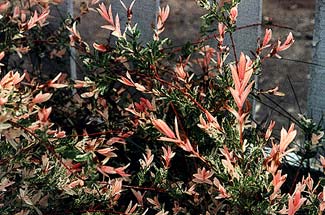 It is spectacular in all seasons. It has yellow catkins in early Spring, shown in the early April (2002) close-up at the left more than twice life size. The catkins are followed by mottled green & white foliage which turns salmon-pink by late spring or early summer.
It is spectacular in all seasons. It has yellow catkins in early Spring, shown in the early April (2002) close-up at the left more than twice life size. The catkins are followed by mottled green & white foliage which turns salmon-pink by late spring or early summer.The fifth photo, taken mid-June, shows the shrub in full pink-leaf flourish. The close-up of a pink leaf was taken in July. The 2009 leaf portrait at top was taken in May just as the leaves got good & pink.
It does not drop its long-lasting leaves until rather late in autumn, & will have very pleasant yellow coloration especially in October & November, shown on the Nishiki Page of the Autumn Leaves Gallery. When leaves have finally fallen the limbs will have become showy, either pink or dark red for winter (when, as the December photo shows, it may still have a few of those long-lasting leaves).
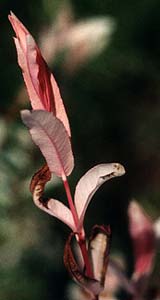 In much colder regions than ours, only the tips of winter branches will turn coral, but in temperate climates the whole length of the limbs turn red.
In much colder regions than ours, only the tips of winter branches will turn coral, but in temperate climates the whole length of the limbs turn red.It likes sun. It also likes lots of water in the springtime when it's putting on its main growth; the rest of the year it's best if it never entirely dries out, yet it is more tolerant of occasional drought than it is of being deluged with waterings.
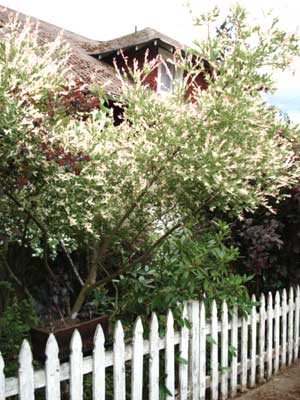 When young it does not weep much, having a striking stiff-limbed starburst form. As it ages the limbs take on more of a willowy droop.
When young it does not weep much, having a striking stiff-limbed starburst form. As it ages the limbs take on more of a willowy droop.It requires very little pruning if one eventually wants a to-die-for eight-foot to twe;ve-foot tall, eight-foot wide fountaining shrub, or an even taller upright tree if one obtains the grafted trunked version. It is also response to pruning, however, & can be shaped as it grows, or even trained with one trunk without need of high graft.
Since the pink-as-flowers summer leaves are most numerous on new branches, plus some gardeners will not want it to get quite so wide & big, it can be pruned back early Spring to maintain the starburst appearance & maximize new growth that'll have the best summer leaf color & winter twig color.
Back in July 2002 it was still only about four & a half feet tall & six feet wide, more than twice the size as when we planted it, still in "starburst shrub" mode. After a slow start, the amount of growth it put on after 2003 was extravagant.
To look at it now, it's hard to believe it slightly disappointed us its first two years in the yard, having been so slow to establish, but by its fourth year it became a fantastic showy shrub, & today underlimbed to resemble a little tree, we just love the hell out of it, it's a true showpiece that always gets comments for the flower-pink foliage.
First introduced to the west in 1979, it has become a very widespread nursery offering both as a fountaining shrub & as a slender-trunked sapling of a tree.
To me the grafted one-trunk specimens look kind of weak for far too many years, though at some point they begin to get enough weight on them they do look like real trees instead of bent dustmops. I'm glad ours has natural trunks never grafted, but it's partly luck their form turned out so pleasing since we hadn't much trained it while it was growing.